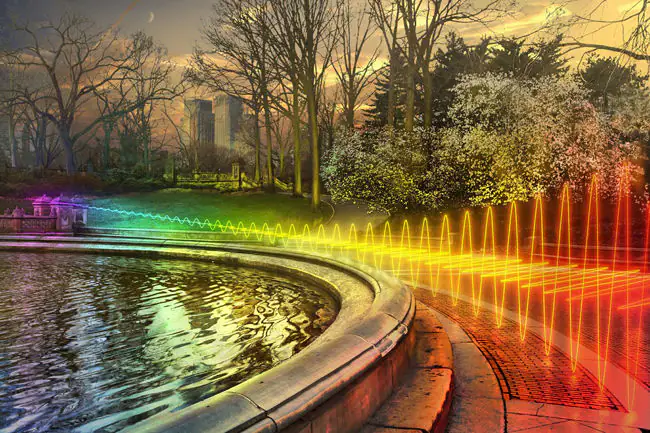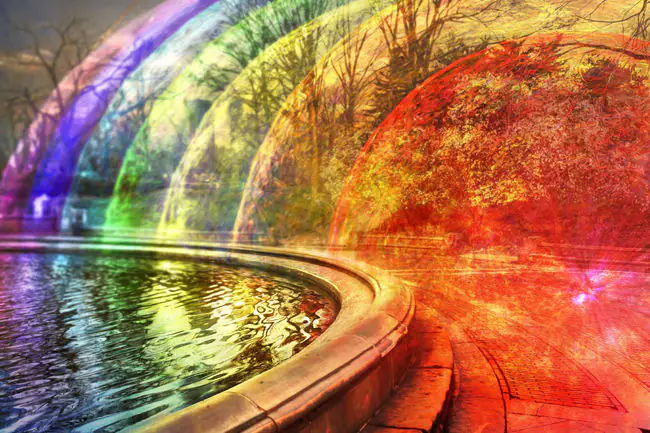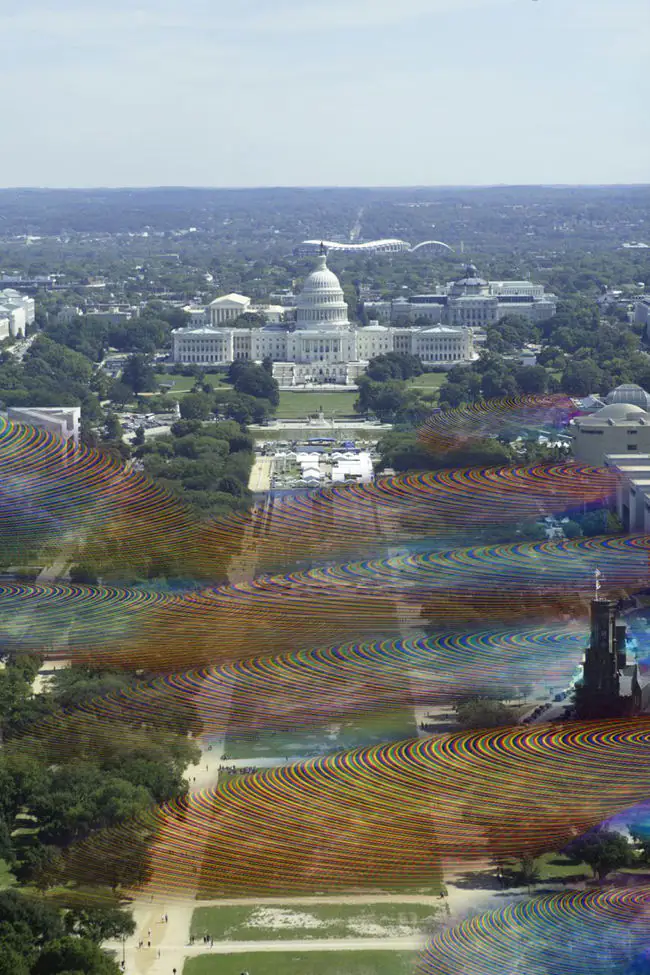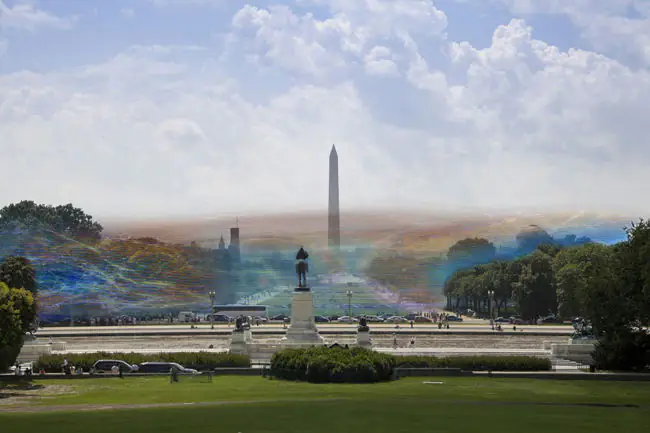What If Wifi Was Visible?
In today’s tech-savvy world, it’s all around you – an invisible world of electromagnetic signals and radio waves.
Wi-Fi, or Wireless Fidelity, is responsible for over 60 percent of the planet’s internet traffic. It’s seemingly everywhere, yet, imperceptible to the human eye. But what if you could see it? What would Wi-Fi look like? And what would it do to you if you could see it? Your eyes are pretty remarkable, and I’m not just saying that to be nice. You can see colors over an electromagnetic wavelength anywhere from 410 nanometers (here you’ll find violet) to roughly 680 nanometers (the home of red).
This is what we call “visible light,” also known as the visible spectrum. Its what humans can view without the aid of any fancy tech devices. Things like Wi-Fi are invisible to the human eye. But what if it’s wasn’t? What would Wi-Fi look like? There are upwards of 4 billion people accessing the internet around the world. That’s a lot of Wi-Fi signals. If you could see them, you would be peeking into the unseen world of electromagnetic fields. Wi-Fi is all about transmitting and receiving data in the gigahertz (GHz) range. If you woke up one day with the ability to see these signals, you would see frequencies up to 30 GHz, wavelengths greater than 10 millimeters (0.4 inches). Not so bad, right? Well, it is speculated that Wi-Fi waves, or pulses, are approximately 15 centimeters (six inches) apart. So imagine a bombardment of colored bands taking over your vision. And that’s just in your bedroom.
With everything we have in our homes that relies on Wi-Fi and the ever-expanding availability of the signal, like city-wide public Wi-Fi networks, the visual stimulation would be too much. So what would happen to you if you started seeing Wi-Fi? It would be overwhelming, to say the least. Prepare yourself for the worst headache in the history of headaches. It would be inescapable. Wi-Fi routers or antennas can be attached to almost anything, including trees, buildings, lamp posts and other structures. If you think that fleeing to the wilderness would work, a typical outdoor router can project its signal 300 feet or more from its location. All those routers will be creating a circular data field around them. Talk about being surrounded!
There have also been claims that just being exposed to electromagnetic fields can cause symptoms of anxiety, depression, nausea and suicidal thoughts. So, imagine what would happen if you could see them. If you could see these signals, you would probably be looking for the deepest cave you could find to hide in, to escape from the constant barrage of lights and freakiness. But, could something like this actually happen? Well, technically we could make this a reality, but it’s not something that would ever occur naturally. It’s easy to take a pair of, say, infrared goggles off. But if you were stuck with this ability forever, you’d be crushed by the overwhelming amount of visual input.
Overall, the idea of being able to witness Wi-Fi in action sounds like a really cool idea, but we should limit it to our technology, not ourselves. Thankfully, our natural eyes aren’t capable of seeing this invisible world, and we should consider ourselves lucky. Electromagnetic waves can have all sorts of strange results on us. It’s even theorized that the phenomenon is responsible for what we know as “ghosts.” It makes you think, doesn’t it? Subscribe to What-If on YouTube or follow the show on Facebook Watch.
Sources
- “Here’s What Wi-Fi Would Look Like If We Could See It”. 2013. Vice. Accessed December 10 2019.
- “Reading on Color & Light, Part I”. 2019. asu.edu. Accessed December 10 2019.
- “How Does Wi-Fi Work?”. Escobar, Eric. 2015. Scientific American. Accessed December 10 2019.
- “Internet Stats & Facts for 2019”. 2018. hostingfacts.com. Accessed December 10 2019.
- “Here’s How Wi-Fi Actually Works”. John Patrick Pullen, 2019. Time. Accessed December 10 2019.
Here’s What Wi-Fi Would Look Like If We Could See It
Wi-fi. It’s all around us, quietly and invisibly powering our access to the world’s information. But few of us have a sense of what wi-fi actually is, let alone what it would look like if we could see it.
Artist Nickolay Lamm, a blogger for MyDeals.com, decided to shed some light on the subject. He created visualizations that imagine the size, shape, and color of wi-fi signals were they visible to the human eye.
«I feel that by showing what wi-fi would look like if we could see it, we’d appreciate the technology that we use everyday,» Lamm told me in an email. «A lot of us use technology without appreciating the complexity behind making it work.»
To estimate what this would look like, Lamm worked with M. Browning Vogel, Ph.D., an astrobiologist and former employee at NASA Ames. Dr. Vogel described the science behind wireless technology, and Lamm used the information to create the visualizations.
Dr. Vogel provided captions for each illustration explaining the science of wi-fi. The caption for the illustration at the top of the article describes the size of a wi-fi energy field, and how a signal is transmitted. It says:
Wifi is an energy field that is transmitted as waves. The waves have a certain height, distance between them and travel at a certain speed. The distance between wifi waves is shorter than that of radio waves and longer than that of microwaves, giving wifi a unique transmission band that can’t be interrupted by other signals. Wifi waves are about 3 to 5 inches from crest to crest. The crests of waves is translated to a 1 by a computer, and the the troughs equal a 0. Chains of 1s and 0s that can be translated into the letters, numbers and codes that make up websites, email and other internet content. Typical wifi waves decrease in amplitude as they travel further from the source which is why the waves are larger to the right and smaller to the left, assuming the source is somewhere near the right of the image. This image shows an idealized wifi data transmitted over a band that is divided into different sub-channels, which are shown in red, yellow, green and other colors.
The wi-fi visualizations are set in Washington, DC. Lamm used data from a map on DC.gov to approximate the size and shapes of wi-fi networks over the National Mall.
Below are Lamm’s images, with Dr. Vogel’s captions underneath.
Wifi waves travel through space as rapid, data encoded pulses or waves. A freeze frame of these pulses would show that the pulses are about 6 inches apart (as shown by the lightly colored bands traveling through space in this image). Wifi routers are basically antenna that can send data over multiple frequencies all at the same time. These multiple frequencies are shown as blue, green, yellow, and red colors that pervade the space around the mall. The data from these multiple frequencies swirls around in space as shown here, but can be translated using a common tag system understood by wireless devices.
Wifi occupies the radio frequency band of the electromagnetic spectrum between actual radio waves and microwaves (used to listen to the game, and cook your dinner, respectively). This frequency band means that wifi boxes and computers can send and receive data as electromagnetic wave that have a 3 to 5 inch distance distance between each pulse of the wave. The wifi pulses are shown here as multicolored spheres radiating out from the source, near the right of the image. Wifi transmitters are basically an antenna equipped with a transmission protocol that splits the frequency band into several segments, referred to as channels. Data can be transmitted over each channel or in order to send and receive greater quantities of data at faster rates. Although color represents its own unique, visible segment of the electromagnetic spectrum, we use red, orange, yellow and other colors to show the invisible wifi channels that make up the overall wifi signal. Wifi fields are usually spherical (like the one here) or ellipsoidal and extend about 20-30 meters, assuming a typical off the shelf wifi box.
What If It Was Possible To See WiFi?
Wifi is an energy field usually transmitted in form of waves. These waves have a definite distance between them, a height and travel at a given speed. Wifi has a distinctive transmission band that makes it hard for other signals to interrupt it. This is because the distance between wifi waves is shorter than that of radio waves and longer than that of microwaves. This is an image showing idealized wifi data being transmitted over a band divided into several different sub channels, represented by yellow, red, green and other colors.
Wifi pulses are represented by the multicolored spheres radiating from the source which is near the image’s right side. Wifi transmitters are essentially an antenna that is equipped with transmission protocol that usually splits the frequency band into numerous segments, also known as channels. Data is transmitted over each channel and can be sent and received in great quantities at a faster rate. The colors orange, yellow, red and others are used to show invisible wifi channels that contribute to the making of the overall wifi signal. Fields of Wifi are usually ellipsoidal or spherical and can extend to about 20- 30 meters.
The wifi wave’s travel as rapid, data encoded waves or pulses through space. If we freeze the pulses, they would be about 6 inches apart. Wifi routers are antennas that send data at the same time over multiple frequencies. The data sent from these frequencies then swirls around in space. A common tag system that can be understood by wireless devices can be used to translate this.
The antenna or routers are usually attached to buildings, lamp posts, trees and other structures. Outdoor routers are able to transmit signals to a distance of about 300 feet or sometimes more, from their location. Some objects like trees obstruct signals and multiple wifi routers have to be placed at different positions to augment this.
A circular data field is created around Wifi routers that are affixed to lamp posts, buildings and other objects. These antennas usually have an omnidirectional signal (the circular bands) that extends in all directions equally. Wifi broadcasts normally at a frequency that is between microwaves and radio waves, which means the pulses or waves, are approximately six inches apart (as shown by circular, colored bands).





